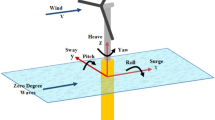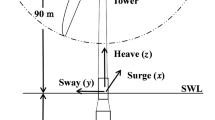Abstract
This paper proposes novel methods for the modeling and control of spar-type floating offshore wind turbines (FOWTs) by focusing on the dependency of the equilibrium and perturbed dynamics on the rotor azimuth angle. In addition, three new reduced models for controller design are derived using trajectory linearization by accounting for the dependency of the equilibrium on the azimuth angle. A thorough simulation study shows that the proposed models reproduce the important dynamic characteristics of FOWTs more accurately than the conventional models. Then, nonlinear model predictive controllers (NMPCs) minimizing the nonquadratic cost functions are developed for the proposed models, which include nonlinear terms for the rotor azimuth angle. These NMPCs suppress the variation in the forces applied to the blades better than the conventional linear MPCs while maintaining a low computational cost. The best NMPC for the models is one that accounts for the dependency of both the equilibrium and perturbed dynamics on the rotor azimuth angle. This NMPC suppresses the platform yaw and forces added on the blades. The performance of such an NMPC can be further improved using the inflow wind disturbance data predicted using a light detection and ranging wind sensor.

















Similar content being viewed by others
References
Musial W, Heimiller D, Beiter P, Scott G, Draxl C (2016) 2016 offshore wind energy resource assessment for the United States. NREL/TP-5000-66599. National Renewable Energy Laboratory, Golden
Musial W, Beiter P, Spitsen P, Nunemaker J, Gevorgian V (2019) 2018 offshore wind technologies market report. NREL/TP-5000-74278. National Renewable Energy Laboratory, Golden
Wright AD, Fingersh LJ (2008) Advanced control design for wind turbines; part I: control design, implementation, and initial tests. NREL/TP-500-42437. National Renewable Energy Laboratory, Golden
Jonkman J, Butterfield S, Musial W, Scott G (2009) Definition of a 5-MW reference wind turbine for offshore system development. NREL/TP-500-38060. National Renewable Energy Laboratory, Golden
Jonkman J (2007) Dynamics modeling and loads analysis of an offshore floating wind turbine. NREL/TP-500-41958. National Renewable Energy Laboratory, Golden
Robertson AN, Jonkman J (2011) Loads analysis of several offshore floating wind turbine concepts. NREL/CP-5000-50539. National Renewable Energy Laboratory, Golden
Shah KA, Meng F, Li Y, Nagamune R, Zhou Y, Ren Z, Jiang Z (2021) A synthesis of feasible control methods for floating offshore wind turbine system dynamics. Renew Sustain Energy Rev 151:111525
Namik H, Stol K, Jonkman J (2008) State-space control of tower motion for deepwater floating offshore wind turbines. In: Proc 46th AIAA Aerospace Sciences Meeting and Exhibit, Reno, 2008-1307
Chaaban R, Fritzen CP (2014) Reducing blade fatigue and damping platform motions of floating wind turbines using model predictive control. In: Proc 9th International conference on structural dynamics. Porto, pp 3581–3588
Raach S, Schlipf D, Sandner F, Matha D, Cheng PW (2014) Nonlinear model predictive control of floating wind turbines with individual pitch control. In: Proc 2014 American Control Conference. Portland, pp 4434–4439
Bir G (2008) Multiblade coordinate transformation and its application to wind turbine analysis. NREL/CP-500-42553, National Renewable Energy Laboratory, Golden
Kane MB (2020) Machine learning control for floating offshore wind turbine individual blade pitch control. In: Proc 2020 American Control Conference. Denver, pp 237–241
Sarkar S, Fitzgerald B, Basu B (2021) Individual blade pitch control of floating offshore wind turbines for load mitigation and power regulation. IEEE Trans Control Syst Technol 29:305–315
Bagherieh O, Hedrick K, Horowitz R (2014) Nonlinear control of floating offshore wind turbines using input/output feedback linearization and sliding control. In: Proc ASME 2014 Dynamic Systems and Control Conference, San Antonio, paper no. DSCC2014-5982
Navalkar ST, van Wingerden JW, Fleming PA, van Kuik GAM (2015) Integrating robust lidar-based feedforward with feedback control to enhance speed regulation of floating wind turbines. In: Proc 2015 American control conference. Chicago, pp 3070–3075
Zhao P, Nagamune R (2019) Switching LPV control of a floating offshore wind turbine on a semi-submersible platform. In: Proc 2019 IEEE 28th international symposium on industrial electronics. Vancouver, pp 664–669
Zhang C, Tahoumi E, Gutierrez S, Plestan F, DeLeón-Morales J (2019) Adaptive robust control of floating offshore wind turbine based on sliding mode. In: Proc IEEE 58th conference on decision and control. Nice, pp 6936–6941
Yu M, Hara N, Konishi K (2021) Blade pitch controller design based on model reference adaptive control for floating offshore wind turbines. In: Proc SICE international symposium on control systems 2021, Online, 2A2-3
Okada Y, Haneda K, Chujo T, Ohtsuka T (2019) Parameter-varying modeling and nonlinear model predictive control for floating offshore wind turbines. In: Proc joint conference 8th IFAC symposium on mechatronic systems and 11th IFAC symposium on nonlinear control systems, Vienna, pp 536–541
Schlipf D, Schuler S, Grau P, Allgöwer F, Kühn M (2010) Look-ahead cyclic pitch control using LIDAR. In: Proc torque from wind third conference. Heraklion, pp 1–7
Scholbrock A, Fleming P, Schlipf D, Wright A, Johnson K, Wang N (2016) Lidar-enhanced wind turbine control: past, present, and future. In: Proc 2016 American control conference. Boston, pp 1399–1406
International Renewable Energy Agency (2016) Floating foundations: a game changer for offshore wind power. https://www.irena.org/-/media/Files/IRENA/Agency/Publication/2016/IRENA_Offshore_Wind_Floating_Foundations_2016.pdf. Accessed 10 Mar 2021
Utsunomiya T, Shiraishi T, Sato I, Inui E, Ishida S (2014) Floating offshore wind turbine demonstration project at Goto Islands, Japan. In: Proc OCEANS 2014-TAIPEI, Taipei, pp 1–7
Jonkman J, Buhl M (2005) FAST User’s Guide. NREL/EL-500-38230, National Renewable Energy Laboratory, Golden
Browning JR, Jonkman J, Robertson A, Goupee AJ (2014) Calibration and validation of a spar-type floating offshore wind turbine model using the FAST dynamic simulation tool. J Phys Conf Ser 555:012015
Jain A, Robertson AN, Jonkman JM, Goupee AJ, Kimball RW, Swift AHP (2012) FAST code verification of scaling laws for DeepCwind floating wind system tests. NREL/CP-5000-54221, National Renewable Energy Laboratory, Golden
Ishida S, Chujo T, Haneda K, Hirao SC, Taniguchi T, Kokubun K, Inoue S (2016) Technological development and safety assessment for floating offshore wind turbines. NMRI Rep 16:107–126
Driscoll F, Jonkman J, Robertson A, Sirnivas S, Skaare B, Nielsen FG (2016) Validation of a FAST model of the Statoil–Hywind Demo floating wind turbine. Energy Procedia 94:3–19
Mitsubishi Electric Corporation Sensing Systems Department (2018) Nacelle-mounted LIDAR. Mitsubishi Electric Corporation, Tokyo
International Electrotechnical Commission, IEC (2009) IEC 61400–3, Wind Turbines Part3: design requirements for offshore wind turbines. IEC, Geneva
Ohtsuka T (2004) A continuation/GMRES method for fast computation of nonlinear receding horizon control. Automatica 40:563–574
Ohtsuka T (2015) A tutorial on C/GMRES and automatic code generation for nonlinear model predictive control. In: Proc European control conference. Linz, pp 73–86
Cybernet Systems Co. (2016) https://www.maplesoft.com/applications/view.aspx?SID=153555. Accessed 10 Mar 2021
Freebury G, Musial W (2000) Determining equivalent damage loading for full-scale wind turbine blade fatigue tests. In: Proc 19th American society of mechanical engineers wind energy symposium. Reno, pp 287–296
Author information
Authors and Affiliations
Corresponding author
Additional information
Publisher’s Note
Springer Nature remains neutral with regard to jurisdictional claims in published maps and institutional affiliations.
This work was partly supported by JSPS KAKENHI Grant Number 15H02257.
About this article
Cite this article
Okada, Y., Haneda, K., Chujo, T. et al. Parameter-varying modeling and nonlinear model predictive control with disturbance prediction for spar-type floating offshore wind turbines. J Mar Sci Technol 27, 589–603 (2022). https://doi.org/10.1007/s00773-021-00854-6
Received:
Accepted:
Published:
Issue Date:
DOI: https://doi.org/10.1007/s00773-021-00854-6




